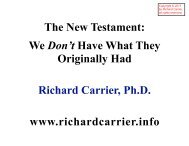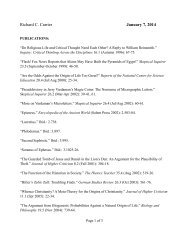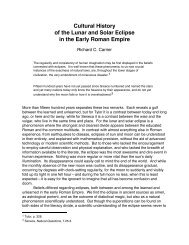“Bayes' Theorem for Beginners: Formal Logic and ... - Richard Carrier
“Bayes' Theorem for Beginners: Formal Logic and ... - Richard Carrier
“Bayes' Theorem for Beginners: Formal Logic and ... - Richard Carrier
Create successful ePaper yourself
Turn your PDF publications into a flip-book with our unique Google optimized e-Paper software.
Bayesian Reasoning Flowchart<br />
- P(e|~h.b) is same or higher = low P(h|e.b) = h is probably false<br />
-- low P(e|h.b) ---|<br />
| - P(e|~h.b) is lower = low P(h|e.b) unless prior is high enough<br />
|<br />
low P(h|b) -------- |<br />
|<br />
| - P(e|~h.b) is lower = low P(h|e.b) unless prior is high enough<br />
-- high P(e|h.b) ---|<br />
- P (e|~h.b) is same or higher = low P(h|e.b) = h is probably false<br />
- P(e|~h.b) is same or lower = high P(h|e.b) = h is probably true<br />
-- low P(e|h.b) ---|<br />
| - P(e|~h.b) is higher = low P(h|e.b) unless prior is high enough<br />
|<br />
high P(h|b) ------- |<br />
|<br />
| - P (e|~h.b) is higher = low P(h|e.b) unless prior is high enough<br />
-- high P(e|h.b) ---|<br />
- P(e|~h.b) is same or lower = high P(h|e.b) = h is probably true<br />
“Low” <strong>and</strong> “High” = lower than 0.5 (50%) <strong>and</strong> higher than 0.5 (50%), respectively; when P(h|b)<br />
= 0.5, so does P(~h|b): then the hypothesis with the higher P(e|b) is probably true.<br />
“Prior is high enough” = when P(h|b) is higher than the Bayesian ratio between either P(e|~h.b) <strong>and</strong><br />
P(e|h.b) or vice versa, enough to overcome the gap <strong>and</strong> thus produce the opposite result.<br />
B. The Application of Probability Theory to Bayesian Reasoning<br />
1. All the rules of probability theory <strong>and</strong> statistical analysis apply to Bayesian<br />
calculations, so the more you know about the <strong>for</strong>mer, the more you can do with<br />
the latter.<br />
For example:<br />
2. Probability estimates in history are usually intuitive <strong>and</strong> thus inexact, there<strong>for</strong>e to<br />
ensure a high confidence level (i.e. a strong enough certainty to warrant<br />
designating your conclusion an objective result of historical inquiry), you must<br />
adopt a wide margin of error.<br />
Since in probability theory (e.g. in scientific polls) the wider the margin of error,<br />
the higher the confidence level, if you widen your margin of error as far as you<br />
can reasonably believe it possible to be, given the evidence available to all expert<br />
24








